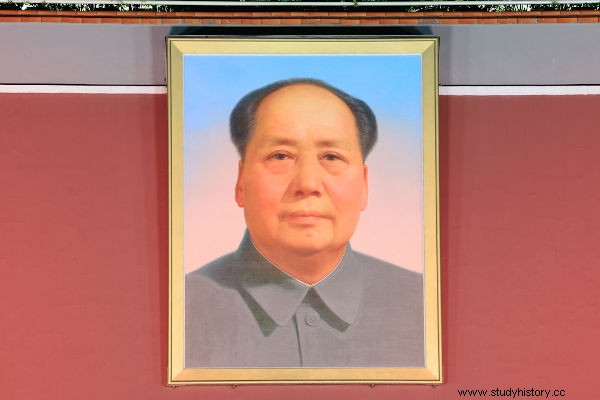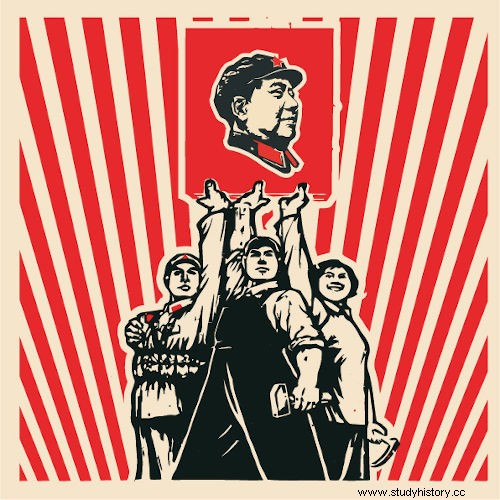Mao Zedong he was one of the greats of China in the 20th century. He became a communist during his youth and joined the Chinese Communist Party (CCP) in the 1920's. . He managed to take over the power of China in 1949, with the victory over the nationalists.
Mao Zedong was one of the most powerful figures in China until the year of his death, 1976. He was behind campaigns such as the Três Anti and Cinco Anti Campaign. He devised the Great Leap Forward, a plan that failed and caused the death of millions of people from starvation. He Carried Out the Cultural Revolution as a way of persecuting your opponents.
Also see: Indochina War - conflict that marked the end of a French colony in Asia
Mao Zedong's birth and youth

Mao Tse-Tung (his name can also be spelled Mao Zedong) born December 26, 1893, in Shaoshan City , located in a province called Hunan. Mao Zedong belonged to a wealthy family , since his father Mao Yichang was a very successful farmer.
Mao's memories tell of his father as a strict and disciplinarian man who eventually beat him and his brothers. Mao Tse-Tung's mother, on the other hand, was called Wen Qimei and had a great devotion to the Buddhist religion. She came to influence her son Mao, but he ended up abandoning religion in his youth.
At age 8, Mao was sent to study and learn Confucian values, completing his primary studies at the age of 13. From there, his father took him back to the farm so he could work. At that age, Mao rejected an arranged marriage which was proposed by his father. To avoid this marriage and continue his studies, Mao ran away from home .
Approaching Communism
Mao's approach to communism took place during his adolescence and youth . After leaving his father's house, he moved to Changsha and continued his studies there. He witnessed major events in Chinese history in 1911, for that year the Chinese monarchy was overthrown, in what became known as the Xinhai Revolution .
The revolutionary experience added to the reading load that Mao had in his youth, especially when he entered a course to train as a teacher. Its formative period spanned from 1913 to 1918, the same time that a socialist revolution took place in Russia.
After graduating, he moved to Beijing and began working at the Peking University library, a job that allowed him to have great contact with Li Dazhao , one of China's most prominent communists in the first decades of the 20th century. Contact with Li Dazhao, therefore, served as a major influence in shaping Mao's political thought.
Dazhao was one of the founders of the Chinese Communist Party (CCP) in 1921, a party that Mao joined in that same year. Mao Zedong was one of the CCP's greats and over time his importance in the party only increased.
Chinese Civil War
Chinese politics lived in times of instability after the establishment of the republic and this situation only worsened in the 1920s. In that decade, one of the great political parties in China was the Kuomintang, the Nationalist Party, which was under the leadership of Sun Yat-sen.
By order from the Soviet Union, theCCP approached the Kuomintang with the objective of guaranteeing the unification of China against the groups that did not yet support the unification of the country under a republican regime. Support for the Kuomintang was believed to be a pre-revolution stage in the country, as unification was supposed to take place before the revolution.
Between 1921 and 1927, the Kuomintang and the CCP acted together in the fight against the warlords that kept China fragmented. The CCP was gaining importance in the country and Mao Zedong became a strong leader within the party, being appointed to chair the party committee in Shanghai.
Mao's militancy took place mainly with the peasants , mobilizing them against the warlords and giving them military training. It was this contact that shaped an important feature of Mao's revolutionary thought:the importance of the peasantry to the success of the revolution.
The relationship between the Kuomintang and the CCP began to deteriorate after 1925, when the party's leader, Sun Yat-sen, died. One of the greats of the Kuomintang, after the death of Sun Yat-sen, was Chiang Kai-shek, a military man who feared the rise of communists in China. Chiang Kai-shek began to sabotage the communists and then went on to openly persecute them.
The persecution of communists it began in 1927, at which time the warlords were weakened and the Kuomintang would no longer need the CCP in the war against them. In 1927, for example, the communists were expelled from Shanghai, and the persecution of the city's communists resulted in the death of 5,000 people. The Kuomintang also mobilized troops to suppress peasant movements in the south of the country.
To defend itself against the Kuomintang, the CCP created an army and appointedMao Zedong to be the commander of Red Army troops , as it was known at first. Mao worked in Hunan and Jiangxi provinces and was harshly persecuted by the Kuomintang, having his second wife, Yang Kaihui, kidnapped and killed in the war.
Persecution made Mao settle in the Jiangxi region, where he became leader of the Jiangxi Soviet . Mao Zedong led the communist resistance in Jiangxi until 1934, when surrounded and pressured by Kuomintang forces, they decided to start a breakout that became known as the Great March .
In this event, about 100,000 soldiers began a walk of more than 10 kilometers to evade nationalist troops. Only 10% survived and settled in Yan'an in 1935. After the Great March, Mao Zedong was appointed CCP leader . From 1937 onwards, the conflicts between nationalists and communists lost strength because of the conflict against the Japanese, the Second Sino-Japanese War.
Login also :What were the WWII conflicts like in Asia?
Chinese Revolution

The confrontation between Chinese and Japanese extended if until 1945 , when Japan was defeated in World War II. Shortly after the Japanese defeat, nationalists and communists resumed conflict with each other. At the end of the Second World War, the panorama in China pointed to the communists very strengthened .
The CCP army came to be known as the People's Liberation Army and had the support of the Soviets. Little by little, the communists conquered territories in China until the moment when Mao Zedong proclaimed the People's Republic of China , October 1, 1949. This event is understood as the victory of the Chinese Revolution.
Defeated, the nationalists fled China and settled in Taiwan (Island of Formosa), forming a dissident government that has no relations with the Chinese government. This situation continues to this day.
Login also :Pol Pot - the man who spearheaded a genocide in Cambodia
Mao Zedong in power
Once the People's Republic of China was founded, Mao put it if as one of the most influential and powerful people in the country . The first plans stipulated by him were aimed at promoting the economic recovery of China, which had the economy in shambles after regular conflicts that had lasted since the 1910s.
Mao also started programs to persecute his dissidents , initially investigating people who had links to the Kuomintang before the CCP's rise to power. These investigations took place through the campaignsThree Anti and Five Anti and resulted in the arrest, torture and execution of thousands of people.
There was also a reform program agrarian which took place at the expense of the lands of former warlords (owners of true fiefdoms), many of whom fought against the CCP. The lands of these feudal lords were taken by the state and distributed to poor peasants to support themselves. Up to two million feudal lords are believed to have been killed during this land reform.
To try to improve the country's economy, Mao created, in 1958, the Great Leap Forward , a plan that sought to reorganize the country's economic production. The outcome of this plan was disastrous, because it disrupted food production in such a way that an outbreak of food shortages spread across China, killing at least 20 million people .
The last great event related to Mao Tse-Tung in China was the Chinese Cultural Revolution . This event took place between 1966 and 1976 and took place through the mobilization of students and younger strata of society to persecute and denounce those who kept the old habits that were related to the bourgeoisie.
This action created a scene of paranoia and ideological persecution in China, which, as an effect, resulted in the near extinction of higher education in the country, since one of the most persecuted groups were teachers. The Cultural Revolution was the result of Mao's strategy to hold on to the CCP's power and to silence its opponents. It is believed that up to two million people were killed in the ten years of the Cultural Revolution.
Death of Mao Tse-Tung
Mao Zedong died September 9, 1976 , aged 82 years. In the last years of his life, he had faced a noticeable weakening of his health condition and, in the year 1976 alone, he had three heart attacks, and the last one (on September 5, 1976) led to his death four days later. .
Image credits
[1] Songquan Deng / Shutterstock
